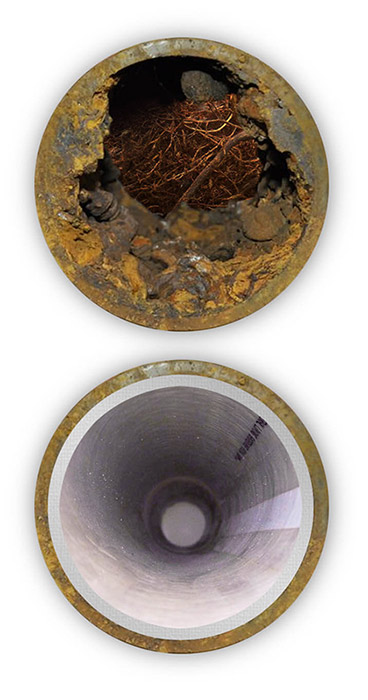Sewer Line Repair Services

High-Quality Sewage Repair in Clinton Township and Surrounding Areas
A sewage system must function properly to drain wastewater from your home. Small issues can result in big problems that prevent drainage or cause hazardous waste to back up. Unfortunately, sewer line problems are often out of sight. At Hoover, we specialize in the latest technologies to protect your property and landscaping and provide sewer line repair using fast, effective, and non-invasive methods that don’t require digging.
How Does a Sewage System Work?
A sewage system is an infrastructure that transports sewage, wastewater, or runoff away from homes and other properties. It consists of several main components:
- Drain Pipes: Wastewater first enters a drain in your sink, shower, or tub. As soon as it hits the drain, water from a plumbing fixture starts flowing into the drainpipe.
- Traps: Not far into the drainpipe is a trap, which holds standing water to prevent sewer gases from rising. If the water in the trap evaporates, a sewage odor may reach your home.
- Branch Drain Lines: These are horizontal pipes pitched slightly downward to allow the continuous movement of wastewater until it reaches the main drain line.
- Soil Stacks: From the branch line, wastewater reaches vertical pipes that transport it to the main sewer line. The top of a stack is vented to the roof to release harmful fumes and balance air pressure in the system.
- Clean-Out: The sewer line clean-out allows easy access to the main line. A plumber often uses it to access and clear a clog. You can, too, if you know its location and how to open it.
- Main Drain Line: A much wider pipe than the branch line, the main drain pipe carries all the wastewater away from your home. A clog here can affect multiple plumbing fixtures.
- Sewer Main: Once wastewater leaves your property, it enters the municipal sewer line, which serves homes and businesses throughout your area. Clogs can cause widespread problems.

Common Sewage Problems
Hoover is familiar with all the common problems that can occur with sewage systems in Troy and Clinton Township. We can quickly address any of these issues we frequently encounter:
- Clogged Drains
- Backed Up Toilets
- Wastewater Overflow
- Sewage Odors
- Leaking Sewer Pipes
- Blocked Sewage Lines
- Tree Root Intrusion
- Broken Sewer Pipes
- Collapsed Sewer Lines
- Shifting Pipes
- Corrosion
What Are the Signs Your Sewage Line Needs Repair?
A sewer line problem will have immediate and potentially hazardous consequences inside your home. Call a sewage repair professional if you’re dealing with any of the following:
Foul Odors and Smells
Organic matter breaks down to form hydrogen sulfide, which is highly toxic and flammable. The sulfuric smell of sewer gas is a combination of hydrogen sulfide, ammonia, methane, carbon dioxide, and nitrogen. The most common cause is a dirty or dry P-trap but a blocked or damaged sewer line or venting problem can also lead to odors.
Slow or Clogged Drains
If clearing dirt, food particles, hair, soap scum, or grease from a drain doesn’t get it flowing again, you may need sewer line repair. Old pipes, a P-trap issue, or tree roots can prevent wastewater lines from working properly. Call a plumber to inspect and, if necessary, repair or replace the damaged sewage line, which requires experience and special tools compared to a minor clog.
Safety and Health Hazards
Sewage not only smells bad. It also contains bacteria and viruses, so exposure to untreated sewage can lead to respiratory and bloodborne infections. Gastrointestinal illnesses, skin infections, and other health issues can also occur. Many of these can become life-threatening if not treated quickly. When working on sewage repairs, our technicians will take steps to protect your home, disinfect the area, and wear personal protective equipment to prevent exposure.
How Is Sewer Line Repair Performed?
Sewage repair requires specialized tools a professional is trained to use. These include CCTV inspection cameras that may be attached to a flexible rod, a remote-controlled crawler, or a self-propelled system. A variety of materials may be chosen to reline a sewer pipe. The liner is inserted into the sewer line using an inversion drum and allowed to cure.
Many types of cutting equipment are used during sewer line repair. A technician may use a chain cutter, laser cutter, or circular cutter. Water jet cutters may also be used. If a major repair isn’t necessary, the line can be cleared using advanced hydro jetting equipment. But when a job would otherwise require excavation, trenchless sewer repair may be implemented; it avoids digging and allows a contractor to fix a sewer line more easily and quickly.
How We Do Sewer Line Repair
At Hoover, our sewage repair process includes the following:
- Initial Assessment and Diagnosis: A thorough inspection of your sewer system allows us to identify the root cause of the problem, no matter its scope, size, or location.
- Repair Options and Recommendations: Depending on the issue, we’ll select suitable repair methods, discuss them in detail with the homeowner, and provide a cost estimate for the project.
- Execution of Sewage Repairs: Upon approval, we’ll proceed with the repair process, whether it requires accessing a cleanout, inserting liner materials into an access point, or replacing a damaged section of pipe.
Every step is executed with care and precision to ensure the issue is fixed and the results are long-lasting.
Post-Repair Maintenance Tips
After performing sewer line repair, our crews complete a post-repair inspection to ensure the repair work was effective. But to avoid future issues, it’s important to:
- Immediately clear out slow/clogged drains
- Avoid flushing solids and caustic liquids
- Often check exposed pipes for leaks
- Have your water pressure tested
- Check for pooling water or dead plants in the backyard
- Call a plumber if there are signs of a leak or other trouble
More Sewage Repair Questions
A sewer drain snake is different from a snake used to unclog a toilet. While one can be rented, a sewer drain snake should only be used by a trained plumber; otherwise, it can be difficult and dangerous to operate.
A plumber can use pipe patching or relining methods to repair a clay sewer pipe. These techniques don’t require digging to fix broken, misaligned, or joint-damaged pipes.
If a drain or sewer pipe under your home cracks, wastewater can seep up through the basement floor. A collapsed line will cause wastewater to accumulate and rise through the basement, crawlspace, or lower-level floor.
Most repairs take between one and three days. Larger jobs can take up to a week. The amount of time depends on the type and extent of the damage, the size of the pipe, and its location.
Call Hoover
We have all the sewer line repair services you need under one roof. To request help, schedule service online or call us at (586) 315-5268 today.

